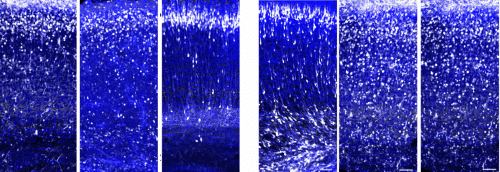Scientists from the Weizmann Institute discovered that the nerve cells in the fetal brain use the proteins of the immune system to find their exact position in the migration process. These findings may shed new light on the conditions of autism, mental retardation and schizophrenia.

Billions of nerve cells migrate in the fetal brain, each looking for its exact location. Scientists from the Weizmann Institute discovered that in this challenging journey the nerve cells receive help from a surprising source: the proteins of the immune system, the same proteins that in later stages of life will help protect the body against bacteria and other disease agents. "The number of proteins in the body is limited, so it makes a lot of sense from an evolutionary point of view to 'cast' the same protein for different roles," says the head of the research group, Prof. Orly Reiner from the Department of Molecular Genetics. "However, we were surprised to find that proteins of the immune system affect the migration of nerve cells in the fetal brain."
Disruptions in the migration of nerve cells in the brain have previously been observed in humans with autism, schizophrenia, and various types of mental retardation, but it was not clear how these disruptions occur. Indeed, much is known about what happens inside the nerve cell during migration, but less about its environment - that is, how cell migration is affected by external signals. In the new study, which was published in the scientific journal Nature Communications., the post-doctoral researcher, Dr. Anna Gorlick, and other members of Prof. Rayner's group, examined about 20 proteins - which were identified in Prof. Rayner's laboratory in a previous study, and it was estimated that they are involved in signaling to the migrating nerve cells, because they are secreted to outside the neurons, or are on the surface of cells that are about to mature into neurons. In the current study, the researchers examined the genes encoding these proteins and discovered, to their surprise, that one of them belongs to the same part of the immune system called the "complement system": a system consisting of a series of proteins that help remove bacteria and damaged cells from the body. Also participating in the study were staff scientists Dr. Tamar Sapir and Dr. Tzvia Olander from the Department of Molecular Genetics, staff scientist Dr. Rebecca Hefner Krause from the Department of Veterinary Resources, and Prof. Trent Woodruff from the University of Queensland in Australia.
The scientists showed that the complement system does control the migration of nerve cells in the fetal brain, after they succeeded in lowering the level of activity of one of the central components of this system - the gene that codes for the 3C protein. After neutralizing the gene in nerve cells of mouse embryos, the researchers saw that the cells did not reach their destination: instead of reaching the upper layer of the cerebral cortex, they remained scattered along their migration path. Moreover, the scientists showed that in the developing brain the 3C protein takes part in the same series of biochemical reactions that are activated in more mature animals during an immune response in the body. The activation of this series causes the protein to split into small molecules, and these activate the receptors of the complement system located on the surface of the nerve cells. Later, when the scientists injected substances that mimic the activity of these molecules into the brains of the transgenic mice lacking the 3C, the problem was corrected and the migration of nerve cells returned to normal.
In the past, hints were found that the immune system might contribute to autism symptoms, but it was not known through what mechanism. The study points to a new direction"

These findings may explain why people suffering from a rare genetic disease, MC3 syndrome, characterized by unusual facial features and problems with various body organs, also have different levels of mental retardation. "Until now, it was not clear how the genetic mutations that lead to this disease - including mutations in the genes that encode proteins in the complement system - can cause mental retardation," says Prof. Rainer. "Our research presents a possible explanation for this. It is possible that these mutations disrupt the normal migration of nerve cells during embryonic development."
The research may also shed new light on the development of autism. The scientists scanned large databases of genetic information, and found that people on the autism spectrum sometimes have mutations in the genes that code for the complement system. Prof. Rayner explains: "In the past, hints were found that the immune system might contribute to autism symptoms, but it was not known through which mechanism. We believe that the mutations in the genes of the complement system may cause problems in the migration of the embryonic nerve cells. This discovery points to a new direction in the study of the neural mechanisms of autism."
#Science_Numbers
The human brain has about 100 billion nerve cells, and between them there are about 1,000 trillion connections.

One response
Stunning !!!
What and all this will be a series of explosions???
really amazing !